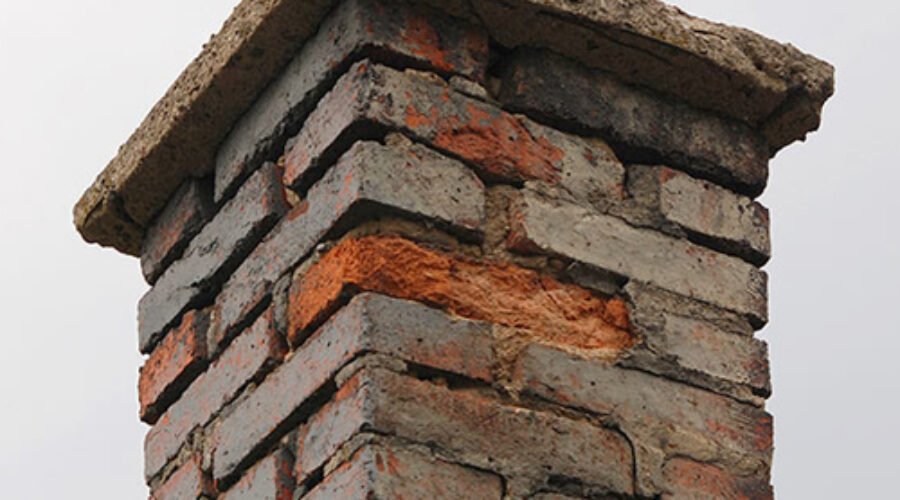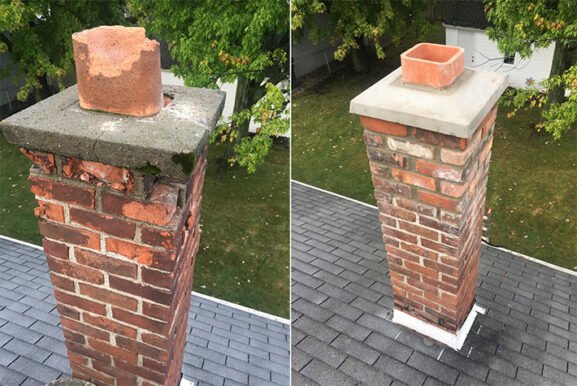Why Timely Mortar Chimney Repair Protects Your Home From Bigger Problems
Key Takeaways
- Cracked or crumbling mortar joints can allow water to seep into your chimney, leading to structural damage.
- Early mortar chimney repairs help preserve your chimney’s integrity and reduce long-term repair costs.
- Repointing, or tuckpointing, is the most effective technique to restore mortar and prevent chimney failure.
- Ignoring mortar damage can result in dangerous chimney instability, heat loss, and moisture intrusion.
Understanding Mortar Damage in Chimneys
Brick chimneys are built to withstand extreme weather and time, but the mortar that binds them is more vulnerable. Over the years, constant exposure to rain, snow, wind, and temperature swings can wear mortar down. As it deteriorates, you may notice cracking, flaking, or even gaps between bricks.
This isn’t just a cosmetic issue. Mortar acts as a seal and structural support for the chimney. Once damaged, it allows water to infiltrate the chimney system, which weakens bricks and can eventually compromise the chimney’s stability. If left untreated, mortar damage can also spread to surrounding masonry or interior walls.
Spotting signs of mortar wear early is key to preventing costly chimney reconstruction. Common indicators include visible cracks, crumbling joints, loose bricks, white staining (efflorescence), or moisture inside the firebox. If you notice any of these, it’s time to act.
The Role of Repointing in Chimney Maintenance
Repointing is the process of removing deteriorated mortar from brick joints and replacing it with fresh mortar. It’s a labor-intensive, detail-oriented repair that restores the strength and weather resistance of the chimney without replacing the entire structure.
The key to effective repointing lies in using the correct mortar mix. Old chimneys often used lime-based mortar, which is more flexible and breathable than modern Portland cement. Using the wrong type of mortar can actually damage the bricks further, especially in older or historic chimneys.
A skilled chimney mason will carefully analyze the existing mortar composition before beginning any repair. They will also ensure that the new mortar matches the color and texture of the original for a seamless finish.
Repointing does not just strengthen the chimney. It helps prevent further moisture infiltration, preserves the thermal efficiency of the fireplace, and maintains the home’s exterior appearance.
How Moisture Accelerates Chimney Deterioration
Moisture is the single biggest enemy of chimneys with failing mortar. When water enters a cracked mortar joint, it doesn’t just weaken that specific area. It spreads through the masonry system, freezes and thaws with the weather, and causes bricks and mortar to expand, contract, and crack further.
This freeze-thaw cycle is especially damaging in cold climates, where even small amounts of trapped water can lead to significant internal damage over time. According to the National Park Service, water trapped in masonry during freezing temperatures exerts up to 25,000 pounds of pressure per square inch — enough to fracture bricks and dislodge large sections of a chimney.
Mortar chimney repair serves as a proactive measure that blocks this infiltration at its source. By sealing and stabilizing joints, you reduce the risk of water getting behind the structure and triggering a chain of damage.
When Mortar Repair Isn’t Enough
There are times when mortar repair alone isn’t enough to restore chimney health. If mortar deterioration has gone too far, the bricks themselves may be loose, cracked, or missing. In such cases, spot repointing might not address the deeper issues.
Structural chimney repair may involve removing damaged bricks, rebuilding sections of the chimney, or installing additional reinforcements like steel rods or chimney crowns. These cases often stem from years of neglected mortar repair.
This underscores the importance of routine chimney inspections — ideally once a year or after major storms. Certified chimney professionals can identify early-stage mortar damage and recommend timely repointing or sealing to avoid major reconstruction.
Seasonal Considerations for Repair Timing
Spring and early summer are ideal times for mortar chimney repair. The weather is generally dry and warm, allowing mortar to cure properly without freezing or excessive moisture. If you wait until fall or winter, you risk working in conditions that could compromise the integrity of the repair.
Moreover, chimney service professionals are often busier in colder months due to the demand for heating system inspections and repairs. Scheduling mortar repair in the off-season ensures better availability, competitive pricing, and enough time for the work to set properly before heavy use.
Don’t wait for visible damage to worsen. Seasonal timing isn’t just about convenience — it’s about protecting your chimney investment before bigger issues arise.
Why Professional Mortar Repair Matters
DIY mortar repairs, such as patching or caulking over cracks, may seem like a cost-saving fix. But these temporary solutions often don’t address the underlying structural weaknesses. Worse, using the wrong materials can trap moisture in the chimney, accelerating damage.
Certified chimney professionals have the tools and experience to assess mortar condition, match historic materials, and perform repairs that last. They follow safety guidelines for working at heights and understand how to maintain ventilation and fire safety during and after the repair.
Additionally, professionals can identify related issues — such as damaged flashing, crown cracks, or flue liner problems — and address them before they evolve into expensive repairs.
Long-Term Chimney Health Starts with Strong Mortar
Your chimney is only as strong as the mortar holding it together. Regular maintenance, early intervention, and expert repair all play a role in extending its lifespan. Prioritizing mortar chimney repair isn’t just about aesthetics — it’s about preventing structural hazards, energy loss, and moisture damage inside your home.
By maintaining your chimney’s mortar, you protect the entire fireplace system and reduce the likelihood of costly, invasive repairs down the line. When you invest in proper upkeep today, you ensure your chimney continues to serve safely and efficiently for years to come.


